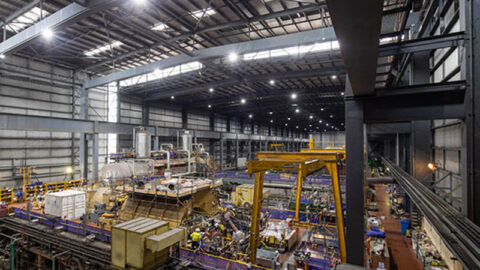By John Thompson, Journalist, Energy Magazine
Electric Vehicle (EV) batteries may soon support the national energy grid during periods of blackout or instability, as demonstrated in an Australia-first trial of vehicle-to-grid technology conducted by researchers from the Australian National University (ANU).
The $6.26 million Realising Electric Vehicle-to-grid Services (REVS) project began in 2020, and sought to demonstrate the feasibility of EVs, particularly those used in corporate and government fleets, collectively discharging their batteries when the national grid needs extra power.
The forward-thinking project seeks to combat the comparative unreliability of renewable energy, which tends to overproduce during periods of low-demand (oftentimes during the day when solar and wind energy is at its most productive) and underproduce during high-demand periods in the evenings.
Solving this are new battery storage facilities – such as Neoen’s ‘big battery’ in Geelong – which store energy for later use and offer so-called grid-firming capacity to ensure the reliable supply of energy no matter the time of day or weather conditions. Though smaller in scale, EV batteries offer similar capabilities and could offer additional capacity during contingency events such as the sudden loss of generating power; often referred to as contingency frequency control.
Australia’s largest-ever V2G trial
Comprising 50 Australian Capital Territory Government-owned EVs and an additional ActewAGL vehicle, the project is the largest demonstration of vehicle-to-grid (V2G) services ever conducted in Australia.
The findings will inform roadmaps and recommendations for the future implementation of V2G services, soon to be released by the ANU REVS research team led by the university’s Battery Storage and Grid Integration Program Research Leader, Dr Björn Sturmberg.
“EV batteries are large – roughly five times larger than household batteries, and when fully charged they typically store about as much energy as an average household uses over two to four days,” Dr Sturmberg said.
“The national fleet of EV batteries could play a vital role in avoiding blackouts by jumping in to support the grid during disturbances, such as a fossil fuel generator trip.” Though implementing the technology was not without its challenges, customer uptake and adoption of V2G services presented researchers with a far greater challenge.
“V2G technology has been in development for decades and is now available in a select number of mass market vehicles and chargers,” Dr Sturmberg said. “The maturity of the technology has been demonstrated in overseas trials but questions remain about customer uptake. We’re seeking to discover what makes V2G attractive to customers, manufacturers and service providers.”
Finding practical incentives
During the trial, the fleet was paid the difference between a V2G-capable car/charger and a non capable car/charger, so that participation didn’t come at a cost.
ANU’s Battery Storage and Grid Integration Program Senior Analyst, Laura Jones, said understanding the needs of EV fleet operators and how best to accommodate them, was a key focus for the trial.
“Whenever you look at these things, they’re not really technical or economic problems. The social bits are often the hardest bits because it’s around what do people see in vehicle-to-grid and can they see it in their lives, what are their concerns,” Ms Jones said.
Ms Jones said that an increasing number of grid-scale battery projects in Australia had diluted the incentives for V2G technology, offering better and perhaps more convenient grid-firming and contingency frequency controls in an as yet small industry.
“Contingency frequency control was chosen because there are very few events a year and when there is an event it’s only a very small percentage of the car’s battery. At the time when the trial was scoped, it was worth a lot of money. It’s probably worth a bit less now because it’s not a very big market,” Ms Jones said.
“The Hornsdale batteries and others that are coming online, they all eat at that market, which means it’s easy to swamp it with these new batteries coming in and make the price quite low. “Money tends to be what people talk about. What’s interesting is that to some extent maybe that’s because that’s how the energy system has usually asked people to do things.
They usually say you could make money. One of the challenges with that is often it ends up small. It’s like, you can hand over control of your battery to the energy system for 37 cents a day and people are like, ‘Wow, sign me up’.”
A closer to home alternative
Understanding the technical and social challenges V2G presented, Ms Jones questioned whether wide-spread adoption of such a technology would be viable or attractive in commercial applications. Instead, she suggested vehicle-to-home technology to be a more attractive alternative for both energy operators and EV fleet owners.
“Vehicle to grid is this idea that the battery is discharging for broader grid purposes and vehicle to home is storing your excess solar, managing your pricing, that sort of thing,” Ms Jones said.
“It feels like vehicle-to-home is going to become more of a thing because it’s an easier thought for people to say you can use your car to make your energy bills lower or to reduce your emissions or whatever it is that floats your boat.” Vehicle to home is an alternative solution, offering perhaps greater incentives, especially to single-vehicle operators.
The concept uses an EV battery to support home energy use, and store the excess energy generated by rooftop solar panels – offering reduced costs and greater independence from the needs of energy operators.
“I think there are a bunch of reasons why people might want to do things and money is one of them. What’s interesting is, if you take the way the energy system seems to be pushing in things like pricing and what vehicle to home might mean for customers, the grid bit is actually not necessarily a focus,” Ms Jones said.
“If you’re talking about the sorts of services we are providing in REVS, they’re kind of esoteric, maybe once a month, it’s less than a percent of your car battery that’s used.”
A bumpy road ahead
Now in its final stages, researchers for the REVS project have begun drafting reports and frameworks to inform a broader understanding of V2G services in Australia. “There’s a heap of reports that we published and another heap to come as well, so it’ll be really good to see once you’ve stapled everything together, whether it works.
Beyond the trial, I can’t speak for the partners of the project here,” Ms Jones said. “I don’t know if they’re intending on rolling this out into an offering at the moment. We just have to ask them given how complicated it’s been. It may not be the case, but we’ll just have to wait and see.”
Technical challenges posed by as-yet unrefined and inconsistent V2G technology further complicates the services utility and can easily discourage would-be adopters of the technology, according to Ms Jones.
“One of the disadvantages of that particular service is it’s probably more technically challenging to deliver than a lot of other ones because you’re going to be able to respond really quickly like the fastest service is between zero and six seconds so you’ve got to respond within a second also,” Ms Jones said.
These challenges, coupled with the need for operators to in some ways hand over control of their assets, demanded better assurances from grid service providers and a leap of faith for would-be adopters.
“The bit that’ll be interesting will be around trust. It’s handing over control to a thing, so the people coming to this journey must be confident that this thing is going to work the way that they’d like it to, and that’s going to be an interesting journey,” Ms Jones said.

















